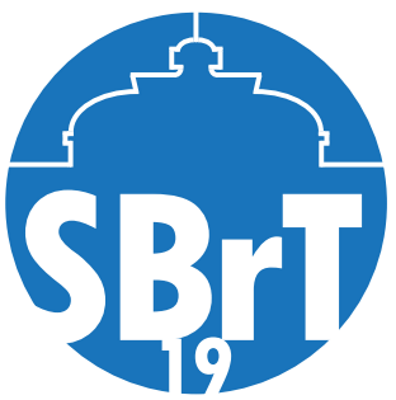
XXXVII Simpósio Brasileiro de Telecomunicações e Processamento de Sinais
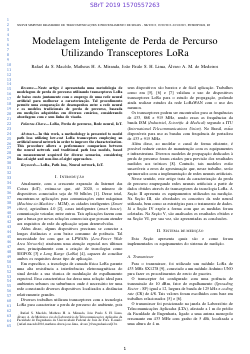
Modelagem inteligente de perda de percurso utilizando transceptores LoRa
Rafael da Silva Macêdo, Matheus Henrique de Abreu Miranda, João Paulo Sales Henriques Lima, Alvaro Augusto Machado de Medeiros
DOI: 10.14209/sbrt.2019.1570557263
Keywords:
Abstract
Neste artigo é apresentada uma metodologia de modelagem de perda de percurso utilizando transceptores LoRa de baixo custo juntamente com o emprego de uma rede neural artificial para melhorar a caracterização. Tal procedimento permite uma comparação de desempenhos entre a rede neural e os modelos tradicionais de perda de percurso, baseada em medições adquiridas em diversos cenários, considerando abordagens com e sem linha de visada.Download
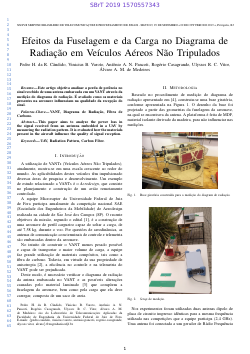
Efeitos da Fuselagem e da Carga no Diagrama de Radiação em Veículos Aéreos Não Tripulados
Pedro Henrique Cândido, Alvaro Augusto Machado de Medeiros, Rogério Casagrande, Ulysses Roberto Chaves Vitor, Antônio Alencar Pancoti, Vinícius Barbosa Varoto
DOI: 10.14209/sbrt.2019.1570557343
Keywords: VANT Diagrama de Radiação Fibra de Carbono
Abstract
Este artigo objetiva analisar a perda de potência no sinal recebido de uma antena embarcada em um VANT através da medição do diagrama de radiação. É avaliado como os materiais presentes na aeronave influenciam na qualidade da recepção do sinal.Download
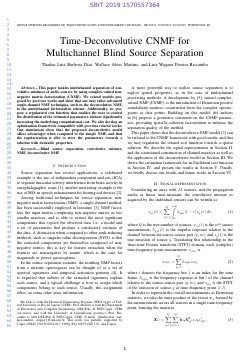
Time-Deconvolutive CNMF for Multichannel Blind Source Separation
Thadeu Luiz B Dias, Wallace A. Martins, Luiz W. P. Biscainho
DOI: 10.14209/sbrt.2019.1570557364
Keywords:
Abstract
This paper tackles multichannel separation of convolutive mixtures of audio sources by using complex-valued non-negative matrix factorization (CNMF). We extend models proposed by previous works and show that one may tailor advanced single-channel NMF techniques, such as the deconvolutive NMF, to the multichannel factorization scheme. Additionally, we propose a regularized cost function that enables the user to control the distribution of the estimated parameters without significantly increasing the underlying computational cost. We also develop an optimization framework compatible with previous related works. Our simulations show that the proposed deconvolutive model offers advantages when compared to the simple NMF, and that the regularization is able to steer the parameters towards a solution with desirable properties.Download
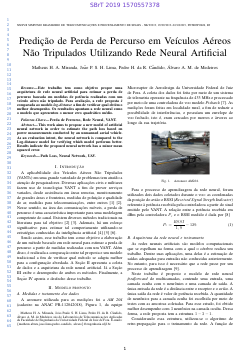
Predição de perda de percurso em veículos aéreos não tripulados utilizando uma rede neural artificial
Matheus Henrique de Abreu Miranda, João Paulo Sales Henriques Lima, Alvaro Augusto Machado de Medeiros, Pedro Henrique Cândido
DOI: 10.14209/sbrt.2019.1570557378
Keywords: Neural network Path loss UAV
Abstract
This work aims to propose a new model of artificial neural network in order to estimate the path loss based on power measurements conducted by an unmanned aerial vehicle. As an evaluation intent, the neural network is compared to the Log-distance model for verifying which model performs better. Results indicate the proposed neural network has a minor mean squared error.Download
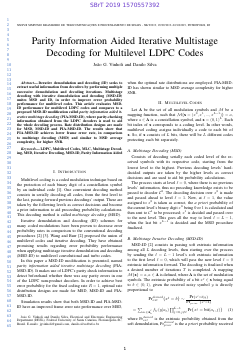
Parity Information Aided Iterative Multistage Decoding for Multilevel LDPC Codes
João Gabriel Vinholi, Danilo Silva
DOI: 10.14209/sbrt.2019.1570557392
Keywords:
Abstract
Iterative demodulation and decoding (ID) seeks to extract useful information from decoders by performing multiple successive demodulation and decoding iterations. Multistage decoding with iterative demodulation and decoding (MSD-ID) unites MSD and ID, in order to improve error probability performance for multilevel codes. This article evaluates MSD-ID performance for multilevel LDPC codes and compares to a proposed MSD-ID modification called \textit{parity information aided iterative multistage decoding} (PIA-MSD-ID), where parity-checking information obtained from the LDPC decoders is used to aid the whole decoding process. Rate distribution designs are made for MSD, MSD-ID and PIA-MSD-ID. The results show that PIA-MSD-ID achieves lower FER, in comparison to multistage decoding (MSD) and similar to MSD average complexity, for higher SNR.Download
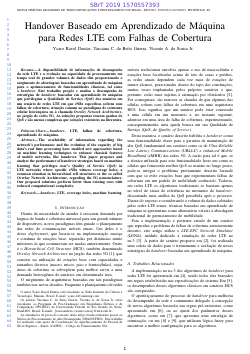
Handover Baseado em Aprendizado de Máquina para Redes LTE com Falhas de Cobertura
Tarciana Cabral de Brito Guerra, Vicente A. de Sousa Jr., Ycaro Dantas
DOI: 10.14209/sbrt.2019.1570557393
Keywords:
Abstract
The availability of information regarding the network's performance and the evolution of the capacity of big data's real time processing have enabled new approaches based on machine learning techniques to enhance classical features of mobile networks, like handover. This paper proposes and analyse the performance of handover strategies based on machine learning that privileges user's Quality of Service (QoS) in LTE networks where specific eNBs witness coverage holes, a common situation in hierarchical cell structures or the so called Overlay Network Architecture, regarding the 5G nomenclature. Our proposed solutions perform better than existing ones with reduced computational complexity.Download
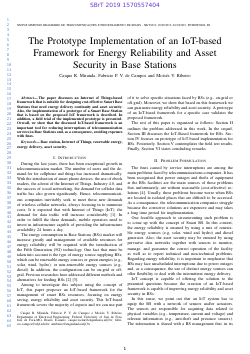
The Prototype Implementation of an IoT-based Framework for Energy Reliability and Asset Security in Base Stations
Caique Miranda, Fabricio Campos, Moises Vidal Ribeiro
DOI: 10.14209/sbrt.2019.1570557404
Keywords:
Abstract
The paper discusses an Internet of Things-based framework that is suitable for designing cost-effective Smart Base Stations that need energy delivery continuity and asset security. Also, the implementation of a prototype of a Smart Base Station that is based on the proposed IoT framework is described. In addition, a field trial of the implemented prototype is presented. Overall, we show that the discussed IoT-based framework is an important tool for reducing interruptions of telecommunication services in Base Stations and, as a consequence, avoiding expenses with fines.Download
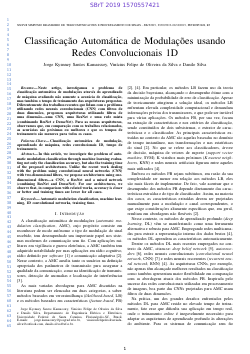
Classificação Automática de Modulações usando Redes Convolucionais 1D
Jorge K S Kamassury, Vinícius F O da Silva, Danilo Silva
DOI: 10.14209/sbrt.2019.1570557421
Keywords:
Abstract
Neste artigo, investigamos o problema de classificação automática de modulações através do aprendizado de máquina avaliando não somente a acurácia de classificação, mas também o tempo de treinamento das arquiteturas propostas. Diferente dos trabalhos recentes que lidam com o problema utilizando redes neurais convolucionais (CNN) com filtros de duas dimensões, propomos arquiteturas utilizando filtros de uma dimensão---uma CNN, uma ResNet e uma rede mista (combinando ResNet e DenseNet). Para as nossas arquiteturas, observamos que, em comparação com os trabalhos relacionados, as acurácias são próximas ou melhores e que os tempos de treinamento são menores para todos os casos.Download
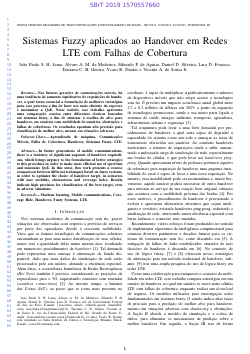
Sistemas Fuzzy aplicados ao Handover em Redes LTE com Falhas de Cobertura
João Paulo Sales Henriques Lima, Alvaro Augusto Machado de Medeiros, Eduardo Pestana de Aguiar, Daniel D. Silveira, Lara Fonseca, Tarciana Cabral de Brito Guerra, Vicente A. de Sousa Jr., Ycaro Dantas
DOI: 10.14209/sbrt.2019.1570557660
Keywords:
Abstract
In future generations of mobile communications, there is a tendency of significant augment of handover requisitions, which brings urgency to the formulation of better strategies to this procedure in order to make more efficient use of spectrum and maximize QoE. In this sense, this work presents a concise comparison between different techniques based on fuzzy systems, in order to optimize the choice of handover target, in scenarios with user mobility, obstructions and coverage holes. Results indicate high precision for classification of the best target, even in adverse situations.Download
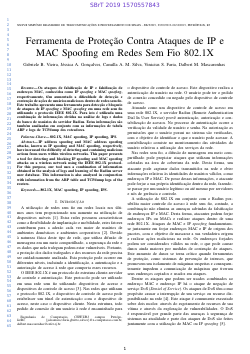
Ferramenta de Proteção Contra Ataques de IP e MAC Spoofing em Redes Sem Fio 802.1X
Dalbert Matos Mascarenhas, Jéssica Gonçalves, Camilla da Silva, Gabriele Vieira, Vinicius Faria
DOI: 10.14209/sbrt.2019.1570557843
Keywords:
Abstract
IP address spoofing and MAC address spoofing attacks, IP spoofing and MAC spoofing respectively, have increased the difficulty of detecting and containing malicious actions from users within wireless networks. This paper presents a tool for detecting and blocking IP spoofing and MAC spoofing attacks on a wireless network using the IEEE 802.1X protocol. For this purpose, our tool uses a combination of information obtained in the analysis of logs and information of the Radius server user database. This information is also analyzed in conjunction with information from the ARP table and TCPdump logs of the routers.Download